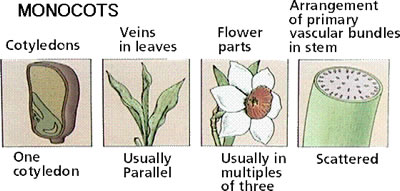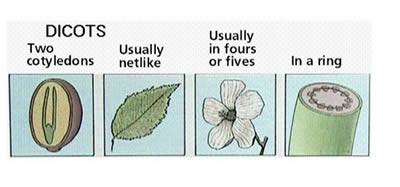Difference between Monocots and Dicots
Key Difference: Monocots and Dicots are both types of flowering plants. The main difference between monocots and dicots is that monocots have only one cotyledon, or embryonic leaf, whereas dicots have two.
 Monocots and Dicots are two subgroups of Angiosperms. Angiosperms are simply nothing more that flowering plants i.e. land plants that reproduce via seeds in flowers and fruits. All angiosperms are classified either into Monocots or Dicots. However, it has been debated that dicots are not a typical group and that it should be further classified.
Monocots and Dicots are two subgroups of Angiosperms. Angiosperms are simply nothing more that flowering plants i.e. land plants that reproduce via seeds in flowers and fruits. All angiosperms are classified either into Monocots or Dicots. However, it has been debated that dicots are not a typical group and that it should be further classified.
As Monocots and Dicots are both types of flowering plants, they are quite similar. However, they do differ in some certain manner, which is why they are classified in this manner. The main difference between Monocots and Dicots is the seed embryo. The seed embryo is the seed from which new plants grow. Monocots have only one cotyledon, or embryonic leaf. This means that when the new plant grows it will shoot up from a single leaf, think of grass. Whereas, a dicot will grow two leaves as its seed contains two cotyledons.
There are also major differences between the seeds, flowers, leaves, and the stems of the two. Monocot flowers tend to have petals in multiples of three, which means that they will have three petals, six petals, nine petals, and so forth. Dicot flowers, on the other hand, tend to have petal in multiples of four or five, so four, five, eight, ten, etc.
Monocots generally have large, fleshy seeds. Their fruits or seedpods are generally comprised of three parts. However, the dicots tends to have a variety of different seeds, fruits or seedpods. There is no one consensus about similarities of similarities of seeds, fruits or seedpods of dicots.
 The veins in the leaves of the monocots are usually arranged in parallel arrangements. Basically, one half is almost a mirror image of the other half. The leaves also tend to be long and narrow in shape. Dicots, however, do not follow the same pattern. The veins in the leaves of dicots are arranged in various patterns. The most common pattern is a crisscross net pattern.
The veins in the leaves of the monocots are usually arranged in parallel arrangements. Basically, one half is almost a mirror image of the other half. The leaves also tend to be long and narrow in shape. Dicots, however, do not follow the same pattern. The veins in the leaves of dicots are arranged in various patterns. The most common pattern is a crisscross net pattern.
Furthermore, the stems of monocots tend to have a scattered arrangement of vascular bundles in them, whereas the vascular bundles in the stems of dicots tend to be in concentric circles. Additionally, monocots have only one furrow or pore in the pollen, whereas dicots have three.
Comparison between Monocots and Dicots:
|
|
Monocots |
Dicots |
|
Also known as |
Monocotyledons |
Dicotyledons |
|
Type of |
Angiosperms (flowering plants) |
Angiosperms (flowering plants) |
|
Embryo |
The seed of the monocots has only one cotyledon, or embryonic leaf. |
The seed of the dicot has two cotyledon, or embryonic leaf. |
|
Flower |
The flower of the monocots has three petals or petals in multiples of three, such as three, six, or nine. |
The flower of the dicots has four or five petals or in multiples of four or five, such as eight, ten, etc. |
|
Pollen |
Has one furrow or pore in pollen |
Has three furrows or pores in pollen |
|
Stem |
Has a scattered arrangement of vascular bundles in the stem |
The Arrangement of vascular bundles in the stem is in concentric circles |
|
Roots |
New roots arise adventitiously from nodes in the stem |
The roots develop from the radical, which is a part of the seed embryo. |
|
Leaf |
Have parallel arrangement of major leaf veins. Most of the times they have long and narrow leaves. |
Have reticulate arrangement of major leaf veins, or in a net pattern. Have variety when it comes to shape and size of leaves. |
|
Seed |
Monocots generally have large, fleshy seeds. Fruits or seedpods are generally comprised of three parts. |
Dicots have a variety size and shape of fruits, seedpods, and seeds. Generally they tend to have a greater number of seeds per seedpod as compared to monocots. |
|
Secondary growth |
Absent |
Often present. New rings of pipes grow each year, so that the stem or trunk grows wider each year. |
|
Examples |
Lilies, orchids, agaves, palms, grasses, corn, rice, wheat, barley, bamboo, sugar cane, pineapples, dates, bananas, etc. |
Castor, tomatoes, potatoes, peppers, cauliflower, cabbage broccoli, turnips, beans, peas, soybeans, clovers, apples, plums peaches, pears, carrot, celery, parsley, etc. |
Image Courtesy: matsuk12.us, pjhsplants.wikispaces.com









Add new comment